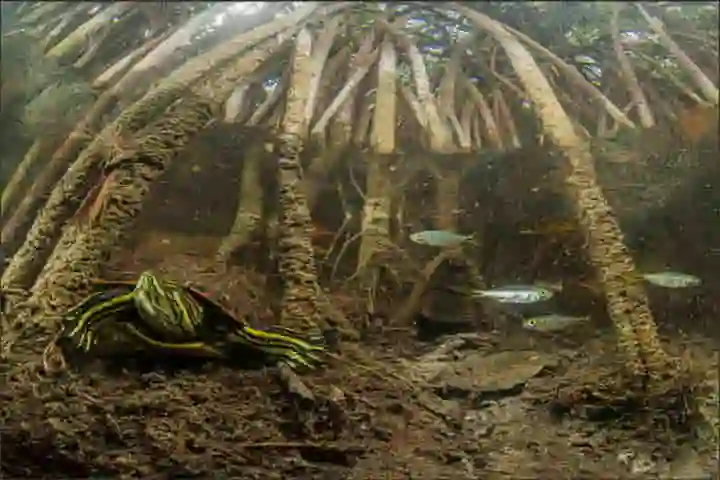Amazing are the ways of nature and a classic example of this are the red mangroves which are blooming along the San Pedro Martir River rainforests on the Yucatan Peninsula located mainly in Mexico. Located 200 kilometres away from the sea, one wonders as to how these forests which are native to salty water have ended up in a freshwater and inland area.
As per an article in sciencenews.org, Carlos Burelo, who as a kid used to visit this area for fishing with his father 35 years ago, was always struck by these mangroves which looked unlike the other vegetation in the region. This impression stayed with him when he grew up to be a biologist at Mexico’s Universidad Juárez Autónoma de Tabasco in Villahermosa.
Also read: Volcanic Eruptions Helped Dinosaurs Evolve And Dominate The Earth For 166 Million Years
Researchers did several studies including genetic analyses, surveys of vegetation and sediments and simulations of shifts in sea levels. These studies came up with a startling revelation – the red mangroves also known as Rhizophora mangle – form a part of a “relict ecosystem”, which have been around for more than 100,000 years ago.

Around 130,000 years ago when the last interglacial period peaked, sea levels rose nearly 9 metres above the levels of today. Thus, the Yucatan Peninsula’s lowlands (present day Belize and parts of Gautemala apart of Mexico) got deluged. The consequence of this change was a shift of mangrove forest which commenced to develop inland according to present standards, said Burelo and colleagues according to a report in Proceedings of the National Academy of Sciences on October 12. As the earth cooled, the level of sea came down and therefore the trees were left very far from the coast.
Commenting on this aspect, Holly Jones, conservation biologist at Northern Illinois University said: “The remarkable resilience of these trees, in particular, is striking — that although they’re normally adapted to seawater, they’ve survived all this time inland is incredible.”
Jones was not involved in the study.
Going further, the researchers wanted to find out where these mangroves had come from. For this they gathered leaves from other mangrove forests and trees which were lined on Caribbean Sea and Gulf of Mexico coasts, for comparing DNA of the plants. The examination unfolded the origin of the inland mangroves – nearly 170 kilometres from the Gulf of Mexico.

The scientists went further as they contrasted a number of DNA mutations taken from the inland mangroves with the others and also used tree cores to work out the age of the trees.
Felipe Zapata, UCLA’s evolutionary biologist observed: “We were able to infer [that the San Pedro mangroves] have been isolated for 120,000 years.” Zapata went on to add that the water and the riverbed of San Pedro which is rich in calcium supported the red mangroves to survive over many years.
The team of scientists also discovered in the inland not just mangroves but also an array of plant species that have a coastal legacy. They disclosed that 112 species or more than 30 per cent of total flora along the river, and these include orchids and legumes, are usually located along shorelines and coastal lagoons.
Also read: Why do humans not have tails – scientists solve the riddle
Having found so many startling discoveries, the team decided to check the soil expecting to locate “coastal sediments, ocean sediments and perhaps ocean fossils,” according to Exequiel Ezcurra, who is an ecologist at Riverside’s University of California. Keeping in line with these predictions, the geologic survey of sediments near the mangroves divulged coastal gravels, shells of marine gastropods, clay sediments rich in shell fragments, coastal dunes and large oyster shells.
In tandem with past sea level simulations these discoveries confirmed that during the last interglacial period a situation occurred whereby the water of the ocean mixed with San Pedro lower basin – leading to pressing the mangroves and other coastal species inland.
Uncovering this relict ecosystem and understanding what happened hundreds of years ago is vital to comprehend how climate change in the past affected the coastline across the globe, according to Ezcurra. He added that it also will help us realise the consequence of rise in sea levels on present ecosystems.




















